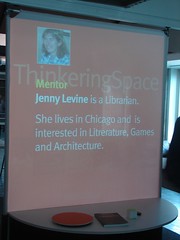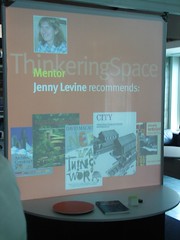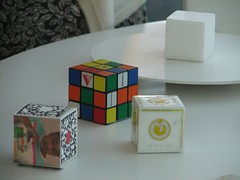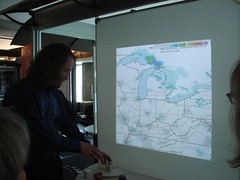करियर विकल्प , बच्चे और अपेक्षा के बोझ तले युवा कुछ देर पहले सडक पर एक पिता शायद अपने छोटे से बच्चे को स्कूल छोडने जा रहे थे.बच्चा स्कूल नही जाना चाह रहा रहा था इसलिए रो रहा था और उसके पिता भी उसे गुस्से मे बोल रहे थे कि स्कूल नही जाएगा तो जमादार बन […]
The post करियर विकल्प , बच्चे और अपेक्षा के बोझ तले युवा appeared first on Monica Gupta.
Yesterday I gave an overview of the Thinkering Spaces project, so today I want to explain a little more about how we were able to manipulate content using the various technologies and objects.
 RFID is a big component of the system, as it identifies content and allows it to travel with an object. To start, the TS folks put a book with an RFID chip on the reader, which triggers a process that displays the cover on the screen, along with a keyboard for typing text to associate with the title. In this case, the container is the book, and the user can draw or type to add content that will travel with it. To illustrate this, they remove the first book and put a second one on the reader. A new cover image appears, along with some information that’s already been added by a previous user. Take that book off and put the first one back on, and the content we added reappears. The whole thing is very cool, and I immediately started thinking about local history collections, schoolwork, and reader reviews. All of which is the point - your librarian mind starts hopping with possibilities.
RFID is a big component of the system, as it identifies content and allows it to travel with an object. To start, the TS folks put a book with an RFID chip on the reader, which triggers a process that displays the cover on the screen, along with a keyboard for typing text to associate with the title. In this case, the container is the book, and the user can draw or type to add content that will travel with it. To illustrate this, they remove the first book and put a second one on the reader. A new cover image appears, along with some information that’s already been added by a previous user. Take that book off and put the first one back on, and the content we added reappears. The whole thing is very cool, and I immediately started thinking about local history collections, schoolwork, and reader reviews. All of which is the point - your librarian mind starts hopping with possibilities.
Then they showed us a library card with an RFID chip in it. This one happened to have information about me stored on it, so putting it on the reader brought up information about me, which rotated with books I recommend. Others in the Thinkering Space could see all of this about me, which would be great if I was working with a group I’m mentoring, coordinating, or collaborating with. The IIT folks understand the privacy issues involved, though, so they’re exploring different ways to handle this. Alternatives include using avatars without personally identifiable information, having the group build a persona to achieve certain skills, and using special cards for collaborative clubs rather than embedding the information in standard library cards (this would provide an opt-in system). None of this is set in stone, but it demonstrates one way in which library users might share information about themselves in the physical library.


Next, we began playing with the story of The Wizard of Oz by placing a Rubik’s Cube with RFID chips on it on a reader. The starter Oz content is attached to this container and it can include the text and images from the book itself. Placing a second, blank, paper “storycube” on the reader brings up a template where someone can use a wand to drag and drop images into a template to tell a story, which can then be saved to another object (in this case, it was a small doll). Putting a second doll on the reader brought up someone else’s story. The container could be anything that uses RFID or barcodes. Turning the cube produces other content, such as weather maps (watch for tornadoes), and putting a camera on the reader brings up pictures and images related to the book, all of which can be manipulated on the screen.



TJ then took some pictures of the group and other objects in the space, and since his digital camera had an Eye-Fi card in it, the pictures began appearing on the screen as well. We could then mash up these pictures with text, sounds, and other digital content to create a narrative, a presentation, a document, or just explore them all together. The space also has a digital microscope and a webcam that can project images onto the screen as well.
We also played with a collaborative drawing table that just does a basic coloring demo right now. However, the idea is that there might be some projects where users can work on their own pieces separately to build a larger whole, or they may have to collaborate and work together as a team to create something. Sometimes they might have their head down working, but other times they might have their head up, interacting with the other participants. Pretty much everything in the space is based on collaboration, as opposed to single users.
What I like about these ideas is that they expand on existing content in the library, using the library’s collection, and mashing it up with users’ ideas to create something new. It’s Jon Udell’s remixed physical library, not just the online one. Or the users create something new from the beginning, based on their interactions with our collections and services. The community can contribute content and knowledge, and the library could archive it.
And it doesn’t have to be just for kids or students. For seniors who have trouble using a mouse and a computer, a setup that lets them use a wand (or even better, their fingers) to drag objects might allow them to play with digital content (especially local history) in different ways. Could families create genealogical histories this way and mash them up with community resources? The Shanachies in the Netherlands intend to build a giant screen in the DOK Library Concept Center where residents can post their own stories and pictures. Imagine combining that with library cards that let those residents update their stories and remix them in a Thinkering Space.
It will be interesting to see what happens to things like narrative and copyright in these types of environments. One of the questions now is will libraries be one of them? This project gives me hope that the answer is yes, and honestly, what better institution do we have in which to discuss, explore, and implement the answers?
collaboration,
iit,
illinois institute of technology,
institute of design,
jon udell,
libraries,
macarthur foundation,
remixed library,
thinkering spaces
In case you didn’t catch it in January, check out here what the PaperTigers reading Challenge 2008 entails: there’s still plenty of time to join in!
We are running three in parallel in our household as my boys decided they wanted to complete it on their own, as well as do one as a bed-time readaloud… so here are our comments about Book Number One!
Back in October, I wrote a post about I Am Jack by Susanne Gervay - the time to  read it came at the end of January when Big Brother had a few issues with bullying (now, I’m glad to say, resolved). As usual, I turned to stories as a springboard for discussion and we read it all together as our first Reading Challenge readaloud. Big Brother’s situation had been squashed very early on and certainly never got anywhere near what poor Jack has to endure but reading the book opened up comparisons and empathy. It brought home the importance of talking - and being available to listen. A couple of bedtimes were prolonged to read an extra chapter; and we had a very late night as we arrived at the end – we couldn’t possibly have left it hanging. Once again, I really recommend this book…
read it came at the end of January when Big Brother had a few issues with bullying (now, I’m glad to say, resolved). As usual, I turned to stories as a springboard for discussion and we read it all together as our first Reading Challenge readaloud. Big Brother’s situation had been squashed very early on and certainly never got anywhere near what poor Jack has to endure but reading the book opened up comparisons and empathy. It brought home the importance of talking - and being available to listen. A couple of bedtimes were prolonged to read an extra chapter; and we had a very late night as we arrived at the end – we couldn’t possibly have left it hanging. Once again, I really recommend this book…
Meanwhile, Big Brother* (aged 9) chose Mga Kuwentong Bayan: Folk Stories from The Philippines edited by Alice Lucas and illustrated by Carl Angel. It is published by Many Cultures Publishing, a division of the nonprofit San Francisco Study Center. The book contains three stories: A Creation Story, The Monkey and the Turtle and Aponitolou and the Star Maiden. Here’s what Big Brother has to say about it:
 I thought it was brilliant – especially the story where all the stars came onto the ground. It was about a star woman and a human man who fell in love with each other and the husband already had a wife on earth so he had to spend half a year in the sky and half a year down on the ground. I thought it was quite fun to have a different kind of book to read, with almost black and white pictures. I tried reading the Tagalog version but I didn’t get very far!
I thought it was brilliant – especially the story where all the stars came onto the ground. It was about a star woman and a human man who fell in love with each other and the husband already had a wife on earth so he had to spend half a year in the sky and half a year down on the ground. I thought it was quite fun to have a different kind of book to read, with almost black and white pictures. I tried reading the Tagalog version but I didn’t get very far!
Little Brother (aged 6) had chosen The Birdman by Veronika Martenova Charles and illustrated by Annouchka Gravel Galouchko and Stéphan Daigle. It is the poignant true story of a Calcutta tailor who buys and sets  free the sickly birds that are left at the end of a day’s trading at the market. You can read PaperTigers’ review of the book here, and here are Little Brother’s comments:
free the sickly birds that are left at the end of a day’s trading at the market. You can read PaperTigers’ review of the book here, and here are Little Brother’s comments:
I really liked the pictures because they looked very artistic with lots of bright colours and dots on them. I really liked Noor Nobi’s idea of making a flock of poor birds. He set them free and they didn’t go far away because they loved him. I liked that it was a true story because something like that is very good and kind.
We will keep you posted on Number 2 of our Reading Challenge selections. In the meantime, do let us know how you’re getting on, if you’re already on board; or let us know your book choices, if you’re just starting.
* I have Here and There Japan to thank for helping me finally to come up with what to call my children in my blog postings: other possibilities had been commented upon and others were too much of a mouthful… I think this now works?!? So thank you, Annie!
 I have to admit, I had never heard of sijo, a traditional Korean verse form, until we received a review copy of Linda Sue Park’s gorgeous little book Tap Dancing on the Roof. What a wonderful partnership the poems and Istvan Banyai’s adorably quirky illustrations make!
I have to admit, I had never heard of sijo, a traditional Korean verse form, until we received a review copy of Linda Sue Park’s gorgeous little book Tap Dancing on the Roof. What a wonderful partnership the poems and Istvan Banyai’s adorably quirky illustrations make!
A sijo is typically divided into three lines of fourteen to sixteen syllables each – though apparently in English they are sometimes divided up into six lines. Unlike their sister genre, the haiku, they can be about anything and they usually have a twist/ joke at the end. It is amazing how much can be conveyed in those few, succinct sound bites! With poems like these, there’s no excuse for missing out on that bedtime story. A beginning, a middle and an end are conjured up in less than a minute.
I would love to quote some of these sijo here at length but obviously that is not possible for copyright reasons. I will content myself with this tantalising beginning of the last gem in the book entitled “Wish”:
For someone to read a poem
again, and again, and then,
Now you must all rush out and buy/ pester your libraries to get hold of a copy so you can find out the rest of it – and read the others - both for yourselves and with the young people in your lives.
I know I’m slightly behind the times on this – several blogs have already waved the flag, including A Year of Reading, PACL Kids and Three Silly Chicks – I do like their conclusion that
It’s the book equivalent of a hot fudge sundae with a cherry on top.
Hmm. I’m sure there’s a sijo in there somewhere! Anyway, it’s definitely one of those books worth making a noise about – with or without the dancing shoes.
We are including Tap Dancing on the Roof in our choices for the PaperTigers Reading Challenge (have you made your mind up yet?). I can’t wait to see if my boys will start writing some sijo of their own. And if you do, please do add them on here so we can all read them.
Mentor Texts, Read Alouds and More is the gathering place for this week’s Poetry Friday… see you there!
PaperTigers’ Books at Bedtime section of our blog is now a part of the new, exciting Tiger’s Bookshelf, which was launched this week. We welcome Janet, our new blogger, who is encouraging young people to join our virtual book-club – see her introductory post for background and details. Books at Bedtime will continue to recommend books for reading aloud (not just at bedtime!) and to celebrate this new development, we are launching our PaperTigers’ Reading Challenge to carry us through to the end of the year.
So here’s the deal:
Choose one book from or about each one of the five geographical areas shown on the PaperTigers map and …

have them read aloud to you,
or read them aloud to your children/class/bookgroup,
or read them yourself
between now and 30th June.
The books can be picture-books, poetry, fiction, non-fiction… the choice is yours.
Let us know your list and then what you thought of them when you’ve completed the challenge.
You can find lots of ideas in the PaperTigers Reviews section and here are some links to other reading lists that might help you – or pop into your local library for some inspiration. Then, when you’ve made a note of the many books you’d like to choose, there’s always the sticking-a-pin-in method… and of course there’s no reason why you can’t start all over again with another five books when you’ve finished!
We’ve decided on three different challenges in our household: one family readaloud then each of the boys will choose their own reading list… Deciding on the logistics was the easy part; I’ll let you know soon which books we actually whittle our lists down to. And we look forward to hearing about your adventures on the PaperTigers Reading Challenge too!














Thanks, Marjorie! I like that you put their ages in ()s. I think I’ll start doing that. I may even go back to add it! Wish I had thought of it 2 years ago!
annie
Marjorie, your sons’ reviews are quite wonderful! Thank you for letting us read them.
Thank you, Annie - and if I’ve given you an idea too, I’m delighted!
Janet, thank you for your kind comments. I now have two beaming boys at this end! And it would be great to hear from other young story-time readers / listeners too…
Marjorie - great post and a good idea of putting ages in ()! Picture book highlights from the month of February that my daughter (7) and I have read together:
Just a Minute: A Trickster Tale and Counting Book by Yuyi Morales (Mexico)
Seven Chinese Sisters by Kathy Tucker, illustrated by Grace Lin (China)
Two of Everything - retold and illustrated by Lily Toy Hang (China)
The Wakame Gatherers by Holly Thompson, illustrated by Kazumi Wilds (Japan, USA)
Corinne, this is a wonderful selection of books! Anything in particular your daughter especially loves about any of them? We’ll be featuring a review of The Wakame Gatherers in this month’s update, by the way…
[…] hard to believe that a month has gone by since my first update on our rising to the PaperTigers Reading Challenge but it has and we are just about managing to keep […]